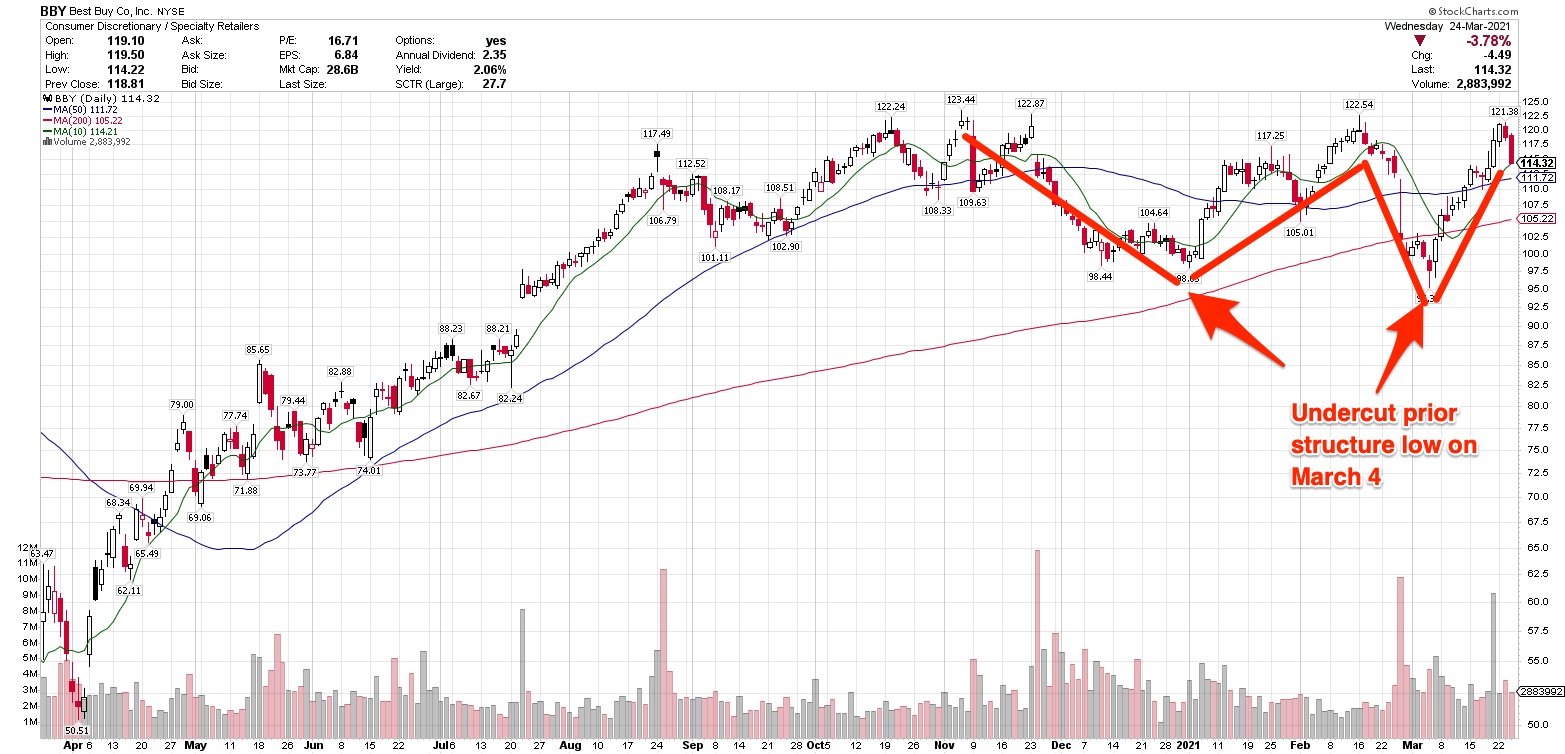 Best Buy NYSE: BBY
Best Buy NYSE: BBY is a little like the character from “Monty Python and the Holy Grail,” who shouts, “Not dead yet” as undertakers try to cart him away.
It was less than a decade ago that the big-box electronics retailer seemed to be on its last legs, losing customers to Amazon (NASDAQ; AMZN). Adding insult to injury, people would troop through the stores, examine the merchandise in person, then order it more cheaply from the online giant.
But the situation is quite different today.
The stock has notched a year-to-date gain of 15.26%, closing Wednesday at $114.32. Its one-year return is 97.08%.
To turn things around, the company brought in new CEO Hubert Joly in 2012. He served in that role until 2019. Among other endeavors, Joly implemented employee engagement programs and upgraded the chain’s internal technology.
The efforts paid off, with the stock posting a five-year return of 31.54%. Earnings growth accelerated over the past five years.
These days, the stock is forming a potentially constructive price consolidation after rallying to an all-time high of $124.89 in November 2020.
Eventually, the effects of diminished store traffic caught up with Best Buy. During the pandemic, customers continued to purchase electronics gear but were buying online instead of in stores.
In February, as the company reported fourth-quarter earnings, the retailer said it laid off 5,000 full-time store employees while adding 2,000 part-timers.
In the announcement about layoffs, the company said it would retrain employees to assist with e-commerce orders, and allocate more space in stores for shipping as well as staging for curbside pickup.
Analyst Ratings Mixed
Analysts’ consensus rating on the stock is a hold, with a price target of $109. That represents a 4.65% downside. That doesn’t tell the entire story, though. Analysts at big investment banks are decidedly mixed in their views about the stock.
On March 9, Citigroup initiated coverage with a sell rating and a price target of $86. But just a few days earlier, Raymond James reiterated its rating of strong buy to outperform, with a price target of $120, representing 4.78% upside potential at the time.
The earnings report was instructional. Earnings per share came in at $3.48, topping Wall Street’s expectation of $3.45 per share, and rising 20% from the year-ago quarter.
Revenue was $16.94 billion, lower than the consensus estimate of $17.23 billion. It was an 11% year-over-year increase.
It’s not necessarily a surprise that in-store sales growth slowed during the pandemic, but perhaps ominously, online sales slowed, as well. While work-from-home technologies, such as headsets and laptops, soared in the early days of the pandemic, along with kitchen appliances to prepare more meals at home, that pace slowed as 2020 wore on.
So where does that leave investors or would-be investors?
Changing Retail Environment
It’s important to note that the company is aware that the business environment is changing, and appears prepared to pivot accordingly. During the fourth-quarter earnings call, CEO Corie Barry addressed the shifting landscape.
“As we think about our strategy moving forward, many of the themes we discussed at our 2019 investor update came to life in a very accelerated way last year,” she said. “It is important to reiterate the following three concepts we believe to be permanent and structural implications of the pandemic that are shaping our strategic priorities.”
She cited those concepts as:
- A permanent shift toward greater online shopping
- A workforce that will demand greater flexibility
- Technology playing a more crucial role in people’s lives
For investors evaluating the stock’s prospects right now, it’s important to understand the price action on its chart. The stock is currently forming a double-bottom pattern.

In this case, the pattern is shaping up ideally, with the second leg of the “W” shape undercutting the first. That can be a sign that institutional investors are paring back their positions, potentially setting the stage for new investors to swoop in at a lower price.
In fact, that seems to have been happening. Since dropping to a structure low of $95.93 on March 4, the stock rallied 19%. Investors could look for a buy point above $121.30, the mid-point of the double-bottom pattern, reached on February 16.
The stock slid 3.78% Wednesday, closing at the bottom of its trading range, but finding support at its 10-day average. That downside price action doesn’t ruin the double-bottom pattern, but you’d like to see the stock resume its upside trajectory without undercutting that March 4 structure low. If that low is breached, it would recharacterize the current pattern.
Before you consider Best Buy, you'll want to hear this.
MarketBeat keeps track of Wall Street's top-rated and best performing research analysts and the stocks they recommend to their clients on a daily basis. MarketBeat has identified the five stocks that top analysts are quietly whispering to their clients to buy now before the broader market catches on... and Best Buy wasn't on the list.
While Best Buy currently has a "Hold" rating among analysts, top-rated analysts believe these five stocks are better buys.
View The Five Stocks Here
Wondering when you'll finally be able to invest in SpaceX, StarLink, or The Boring Company? Click the link below to learn when Elon Musk will let these companies finally IPO.
Get This Free Report